Long-Term Variability of Wind Speed and Direction in the Mediterranean Basin
Abstract
1. Introduction
2. The ERA5 Reanalysis Dataset
3. Theoretical Background and Methodology
4. Numerical Results
4.1. Annual and Interannual Time Scales
4.1.1. Variability Characteristics
4.1.2. Association between Wind Speed and Direction
4.1.3. Wind Speed Trend
4.1.4. Extreme Wind Events
4.2. Monthly Time Scale
- From November to April, there are high wind speed values all over the basin, with the highest values in the Aegean and the Balearic Seas. Wind speed starts to increase during November and continues so until February when it peaks. Then, it decreases until April when it reaches values close to November’s. For most of the basin, the wind speed values are around 7 m/s.
- From May up to September, there are lower wind speeds all over the basin, compared to the previous period; however, the Gulf of Lion and the Aegean Sea still have the highest values. The wind speed in the Aegean Sea increases from May to August and then drops until September. For most of the basin, the wind speed values are around 4.5 m/s.
- During October, wind speed starts to increase all over the basin, especially in the Aegean Sea and the Gulf of Lion.
4.2.1. Variability Characteristics
4.2.2. Association between Wind Speed and Direction
4.2.3. Wind Speed Trend
5. Discussion
6. Conclusions
Author Contributions
Funding
Institutional Review Board Statement
Informed Consent Statement
Data Availability Statement
Acknowledgments
Conflicts of Interest
References
- Ramšak, V.; Malačič, V.; Ličer, M.; Kotnik, J.; Horvat, M.; Žagar, D. High-resolution pollutant dispersion modelling in contaminated coastal sites. Environ. Res. 2013, 125, 103–112. [Google Scholar] [CrossRef] [PubMed]
- Korinenko, A.E.; Malinovsky, V.V. Field study of film spreading on a sea surface. Oceanologia 2014, 56, 461–475. [Google Scholar] [CrossRef]
- Meng, C.; Cheng, T.; Bao, F.; Gu, X.; Wang, J.; Zuo, X.; Shi, S. The Impact of Meteorological Factors on Fine Particulate Pollution in Northeast China. Aerosol. Air. Qual. Res. 2020, 20, 1618–1628. [Google Scholar] [CrossRef]
- Kannemadugu, H.b.s.; Dorligjav, S.; Gharai, B.; Seshasai, M.V.R. Satellite-Based Air Pollution Potential Climatology over India. Water Air Soil Pollut. 2021, 232, 365. [Google Scholar] [CrossRef]
- Pogumirskis, M.; Sīle, T.; Seņņikovs, J.; Bethers, U. PCA analysis of wind direction climate in the baltic states. Tellus A Dyn. Meteorol. Oceanogr. 2021, 73, 1–16. [Google Scholar] [CrossRef]
- Drake, A.; Rock, C.A.; Quinlan, S.P.; Martin, M.; Green, D.J. Wind Speed during Migration Influences the Survival, Timing of Breeding, and Productivity of a Neotropical Migrant, Setophaga petechia. PLoS ONE 2014, 9, e97152. [Google Scholar] [CrossRef]
- Erni, B.; Liechti, F.; Bruderer, B. The role of wind in passerine autumn migration between Europe and Africa. Behav. Ecol. 2005, 16, 732–740. [Google Scholar] [CrossRef]
- Huang, A.C.; Bishop, C.A.; McKibbin, R.; Drake, A.; Green, D.J. Wind conditions on migration influence the annual survival of a neotropical migrant, the western yellow-breasted chat (Icteria virens auricollis). BMC Ecol. 2017, 17, 29. [Google Scholar] [CrossRef]
- Gutierrez Illan, J.; Wang, G.; Cunningham, F.L.; King, D.T. Seasonal effects of wind conditions on migration patterns of soaring American white pelican. PLoS ONE 2017, 12, e0186948. [Google Scholar] [CrossRef]
- Damschen, E.I.; Baker, D.V.; Bohrer, G.; Nathan, R.; Orrock, J.L.; Turner, J.R.; Brudvig, L.A.; Haddad, N.M.; Levey, D.J.; Tewksbury, J.J. How fragmentation and corridors affect wind dynamics and seed dispersal in open habitats. Proc. Natl. Acad. Sci. USA 2014, 111, 3484–3489. [Google Scholar] [CrossRef]
- Gibb, R.; Shoji, A.; Fayet, A.L.; Perrins, C.M.; Guilford, T.; Freeman, R. Remotely sensed wind speed predicts soaring behaviour in a wide-ranging pelagic seabird. J. R. Soc. Interface 2017, 14, 20170262. [Google Scholar] [CrossRef]
- Delitala, A.M.S.; Gallino, S.; Villa, L.; Lagouvardos, K.; Drago, A. Weather routing in long-distance Mediterranean routes. Theor. Appl. Climatol. 2010, 102, 125–137. [Google Scholar] [CrossRef]
- Życzkowski, M.; Szlapczynska, J.; Szlapczynski, R. Review of Weather Forecast Services for Ship Routing Purposes. Pol. Marit. Res. 2019, 26, 80–89. [Google Scholar] [CrossRef]
- Feng, X.; Liu, C.; Xie, F.; Lu, J.; Chiu, L.S.; Tintera, G.; Chen, B. Precipitation characteristic changes due to global warming in a high-resolution (16 km) ECMWF simulation. Q. J. R. Meteorol. Soc. 2019, 145, 303–317. [Google Scholar] [CrossRef] [PubMed]
- Tan, K.; Huang, P.; Liu, F.; Murakami, H.; Hsu, P.-C. Simulated ENSO’s impact on tropical cyclone genesis over the western North Pacific in CMIP5 models and its changes under global warming. Int. J. Clim. 2019, 39, 3668–3678. [Google Scholar] [CrossRef]
- Koletsis, I.; Kotroni, V.; Lagouvardos, K.; Soukissian, T. Assessment of offshore wind speed and power potential over the Mediterranean and the Black Seas under future climate changes. Renew. Sust. Energy Rev. 2016, 60, 234–245. [Google Scholar] [CrossRef]
- Ma, J.; Foltz, G.R.; Soden, B.J.; Huang, G.; He, J.; Dong, C. Will surface winds weaken in response to global warming? Environ. Res. Lett. 2016, 11, 124012. [Google Scholar] [CrossRef]
- Chadee, X.T.; Clarke, R.M. Large-scale wind energy potential of the Caribbean region using near-surface reanalysis data. Renew. Sustain. Energy Rev. 2014, 30, 45–58. [Google Scholar] [CrossRef]
- Kotroni, V.; Lagouvardos, K.; Lykoudis, S. High-resolution model-based wind atlas for Greece. Renew. Sustain. Energy Rev. 2014, 30, 479–489. [Google Scholar] [CrossRef]
- Hasager, C.B.; Mouche, A.; Badger, M.; Bingöl, F.; Karagali, I.; Driesenaar, T.; Stoffelen, A.; Peña, A.; Longépé, N. Offshore wind climatology based on synergetic use of Envisat ASAR, ASCAT and QuikSCAT. Remote Sens. Env. 2015, 156, 247–263. [Google Scholar] [CrossRef]
- Huang, J.; McElroy, M.B. A 32-year perspective on the origin of wind energy in a warming climate. Renew. Energy 2015, 77, 482–492. [Google Scholar] [CrossRef]
- Barthelmie, R.J.; Jensen, L.E. Evaluation of wind farm efficiency and wind turbine wakes at the Nysted offshore wind farm. Wind Energy 2010, 13, 573–586. [Google Scholar] [CrossRef]
- Xoplaki, E.; Trigo, R.M.; García-Herrera, R.; Barriopedro, D.; D’Andrea, F.; Fischer, E.M.; Gimeno, L.; Gouveia, C.; Hernández, E.; Kuglitsch, F.G.; et al. 6-Large-Scale Atmospheric Circulation Driving Extreme Climate Events in the Mediterranean and its Related Impacts. In The Climate of the Mediterranean Region; Lionello, P., Ed.; Elsevier: Oxford, UK, 2012; pp. 347–417. [Google Scholar]
- Kelpšaitė, L.; Dailidienė, I. Influence of wind wave climate change on coastal processes in the eastern Baltic Sea. J. Coast. Res. 2011, 64, 220–224. [Google Scholar]
- Kondrat, V.; Šakurova, I.; Baltranaitė, E.; Kelpšaitė-Rimkienė, L. Natural and Anthropogenic Factors Shaping the Shoreline of Klaipėda, Lithuania. J. Mar. Sci. Eng. 2021, 9, 1456. [Google Scholar] [CrossRef]
- Weisse, R.; Dailidienė, I.; Hünicke, B.; Kahma, K.; Madsen, K.; Omstedt, A.; Parnell, K.; Schöne, T.; Soomere, T.; Zhang, W.; et al. Sea level dynamics and coastal erosion in the Baltic Sea region. Earth Syst. Dynam. 2021, 12, 871–898. [Google Scholar] [CrossRef]
- Stathopoulos, T.; Alrawashdeh, H. Wind loads on buildings: A code of practice perspective. J. Wind Eng. Ind. Aerodyn. 2020, 206, 104338. [Google Scholar] [CrossRef]
- Li, S.H. Design Wind Speed for Buildings and Facilities with Non-Standard Design Life in Canadian Wind Climates. Front. Built Environ. 2022, 8, 829533. [Google Scholar] [CrossRef]
- Snaiki, R.; Wu, T. Knowledge-enhanced deep learning for simulation of tropical cyclone boundary-layer winds. J. Wind Eng. Ind. Aerodyn. 2019, 194, 103983. [Google Scholar] [CrossRef]
- Wang, H.; Wu, T. Statistical Investigation of Wind Duration Using a Refined Hurricane Track Model. In Proceedings of the 6th American Association for Wind Engineering Workshop, Clemson, SC, USA, 12–14 May 2021; pp. 135–137. [Google Scholar]
- Outten, S.; Sobolowski, S. Extreme wind projections over Europe from the Euro-CORDEX regional climate models. Weather Clim. Extrem. 2021, 33, 100363. [Google Scholar] [CrossRef]
- Troccoli, A.; Muller, K.; Coppin, P.; Davy, R.; Russell, C.; Hirsch, A.L. Long-Term Wind Speed Trends over Australia. J. Clim. 2012, 25, 170–183. [Google Scholar] [CrossRef]
- Wohland, J.; Folini, D.; Pickering, B. Wind speed stilling and its recovery due to internal climate variability. Earth Syst. Dynam. 2021, 12, 1239–1251. [Google Scholar] [CrossRef]
- Laurila, T.K.; Sinclair, V.A.; Gregow, H. Climatology, variability, and trends in near-surface wind speeds over the North Atlantic and Europe during 1979–2018 based on ERA5. Int. J. Clim. 2021, 41, 2253–2278. [Google Scholar] [CrossRef]
- Soukissian, T.H.; Karathanasi, F.E.; Axaopoulos, P.; Voukouvalas, E.; Kotroni, V. Offshore wind climate analysis and variability in the Mediterranean Sea. Int. J. Clim. 2018, 38, 384–402. [Google Scholar] [CrossRef]
- Bett, P.E.; Thornton, H.E.; Clark, R.T. European wind variability over 140 yr. Adv. Sci. Res. 2013, 10, 51–58. [Google Scholar] [CrossRef]
- Yu, L.; Zhong, S.; Sun, B. The Climatology and Trend of Surface Wind Speed over Antarctica and the Southern Ocean and the Implication to Wind Energy Application. Atmosphere 2020, 11, 108. [Google Scholar] [CrossRef]
- Koch, W. Directional analysis of SAR images aiming at wind direction. IEEE Trans. Geosci. Remote 2004, 42, 702–710. [Google Scholar] [CrossRef]
- Mahrt, L. Surface Wind Direction Variability. J. Appl. Meteorol. Climatol. 2011, 50, 144–152. [Google Scholar] [CrossRef]
- Pandey, G.; Sharan, M. Accountability of wind variability in AERMOD for computing concentrations in low wind conditions. Atmos. Environ. 2019, 202, 105–116. [Google Scholar] [CrossRef]
- Lang, F.; Belusic, D.; Siems, S. Observations of Wind-Direction Variability in the Nocturnal Boundary Layer. Bound.-Layer Meteorol. 2018, 166, 51–68. [Google Scholar] [CrossRef]
- Voermans, J.J.; Smit, P.B.; Janssen, T.T.; Babanin, A.V. Estimating Wind Speed and Direction Using Wave Spectra. J. Geophys. Res. Ocean. 2020, 125, e2019JC015717. [Google Scholar] [CrossRef]
- Karathanasi, F.; Soukissian, T.; Belibassakis, K. Directional Extreme Value Models in Wave Energy Applications. Atmosphere 2020, 11, 274. [Google Scholar] [CrossRef]
- Coles, S.G.; Walshaw, D. Directional Modeling of Extreme Wind Speeds. J. R. Stat. Soc. Ser. C 1994, 43, 139–157. [Google Scholar]
- Soukissian, T.H. Probabilistic modeling of directional and linear characteristics of wind and sea states. Ocean Eng. 2014, 91, 91–110. [Google Scholar] [CrossRef]
- Song, M.X.; Chen, K.; Zhang, X.; Wang, J. Optimization of wind turbine micro-siting for reducing the sensitivity of power generation to wind direction. Renew. Energy 2016, 85, 57–65. [Google Scholar] [CrossRef]
- Stosic, T.; Telesca, L.; Stosic, B. Multiparametric statistical and dynamical analysis of angular high-frequency wind speed time series. Phys. A Stat. Mech. Its Appl. 2021, 566, 125627. [Google Scholar] [CrossRef]
- Abdelkader, A.; Aly, A.M.; Rezaee, M.; Bitsuamlak, G.T.; El Naggar, M.H. On the evaluation of wind loads for wind turbines’ foundation design: Experimental and numerical investigations. Struct. Des. Tall Spec. Build. 2017, 26, e1362. [Google Scholar] [CrossRef]
- Lamei, A.; Hayatdavoodi, M. On motion analysis and elastic response of floating offshore wind turbines. J. Ocean Eng. Mar. Energy 2020, 6, 71–90. [Google Scholar] [CrossRef]
- Moan, T.; Gao, Z.; Bachynski, E.E.; Nejad, A.R. Recent Advances in Integrated Response Analysis of Floating Wind Turbines in a Reliability Perspective. J. Offshore Mech. Arct. Eng. 2020, 142, 052002. [Google Scholar] [CrossRef]
- Himri, Y.; Merzouk, M.; Kasbadji Merzouk, N.; Himri, S. Potential and economic feasibility of wind energy in south West region of Algeria. Sustain. Energy Technol. Assess. 2020, 38, 100643. [Google Scholar] [CrossRef]
- Karagali, I.; Badger, M.; Hahmann, A.N.; Peña, A.; Hasager, C.B.; Sempreviva, A.M. Spatial and temporal variability of winds in the Northern European Seas. Renew. Energy 2013, 57, 200–210. [Google Scholar] [CrossRef]
- Alvarez, I.; Gomez-Gesteira, M.; Decastro, M.; Carvalho, D. Comparison of different wind products and buoy wind data with seasonality and interannual climate variability in the southern Bay of Biscay (2000–2009). Deep. Sea Res. Part II Top. Stud. Oceanogr. 2014, 106, 38–48. [Google Scholar] [CrossRef]
- Burlando, M. The synoptic-scale surface wind climate regimes of the Mediterranean Sea according to the cluster analysis of ERA-40 wind fields. Theor. Appl. Climatol. 2009, 96, 69–83. [Google Scholar] [CrossRef]
- Bierstedt, S.E.; Hünicke, B.; Zorita, E. Variability of wind direction statistics of mean and extreme wind events over the Baltic Sea region. Tellus A Dyn. Meteorol. Oceanogr. 2015, 67, 29073. [Google Scholar] [CrossRef]
- Klink, K. Climatological mean and interannual variance of United States surface wind speed, direction and velocity1. Int. J. Clim. 1999, 19, 471–488. [Google Scholar] [CrossRef]
- McVicar, T.R.; Roderick, M.L.; Donohue, R.J.; Li, L.T.; Van Niel, T.G.; Thomas, A.; Grieser, J.; Jhajharia, D.; Himri, Y.; Mahowald, N.M.; et al. Global review and synthesis of trends in observed terrestrial near-surface wind speeds: Implications for evaporation. J. Hydrol. 2012, 416–417, 182–205. [Google Scholar] [CrossRef]
- Vautard, R.; Cattiaux, J.; Yiou, P.; Thépaut, J.-N.; Ciais, P. Northern Hemisphere atmospheric stilling partly attributed to an increase in surface roughness. Nat. Geosci. 2010, 3, 756–761. [Google Scholar] [CrossRef]
- Watson, S.J.; Kritharas, P.; Hodgson, G.J. Wind speed variability across the UK between 1957 and 2011. Wind Energy 2015, 18, 21–42. [Google Scholar] [CrossRef]
- Cos, J.; Doblas-Reyes, F.; Jury, M.; Marcos, R.; Bretonnière, P.A.; Samsó, M. The Mediterranean climate change hotspot in the CMIP5 and CMIP6 projections. Earth Syst. Dynam. 2022, 13, 321–340. [Google Scholar] [CrossRef]
- Zecchetto, S.; De Biasio, F. Sea surface winds over the Mediterranean basin from satellite data (2000–04): Meso- and local-scale features on annual and seasonal time scales. J. Appl. Meteorol. Climatol. 2007, 46, 814–827. [Google Scholar] [CrossRef]
- Ragone, F.; Meli, A.; Napoli, A.; Pasquero, C. Ocean Surface Anomalies after Strong Winds in the Western Mediterranean Sea. J. Mar. Sci. Eng. 2019, 7, 182. [Google Scholar] [CrossRef]
- Gomez-Delgado, F.d.P.; Gallego, D.; Peña-Ortiz, C.; Vega, I.; Ribera, P.; Garcia-Herrera, R. Long term variability of the northerly winds over the Eastern Mediterranean as seen from historical wind observations. Glob. Planet Change 2019, 172, 355–364. [Google Scholar] [CrossRef]
- Lionello, P.; Bhend, J.; Buzzi, A.; Della-Marta, P.M.; Krichak, S.O.; Jansà, A.; Maheras, P.; Sanna, A.; Trigo, I.F.; Trigo, R. Chapter 6 Cyclones in the Mediterranean region: Climatology and effects on the environment. In Developments in Earth and Environmental Sciences; Lionello, P., Malanotte-Rizzoli, P., Boscolo, R., Eds.; Elsevier: Amsterdam, The Netherlands, 2006; Volume 4, pp. 325–372. [Google Scholar]
- Flocas, H.A.; Simmonds, I.; Kouroutzoglou, J.; Keay, K.; Hatzaki, M.; Bricolas, V.; Asimakopoulos, D. On Cyclonic Tracks over the Eastern Mediterranean. J. Clim. 2010, 23, 5243–5257. [Google Scholar] [CrossRef]
- Lira-Loarca, A.; Ferrari, F.; Mazzino, A.; Besio, G. Future wind and wave energy resources and exploitability in the Mediterranean Sea by 2100. Appl. Energy 2021, 302, 117492. [Google Scholar] [CrossRef]
- Soukissian, T.; Karathanasi, F.; Axaopoulos, P. Satellite-Based Offshore Wind Resource Assessment in the Mediterranean Sea. IEEE J Ocean. Eng. 2017, 42, 73–86. [Google Scholar] [CrossRef]
- Majidi Nezhad, M.; Heydari, A.; Neshat, M.; Keynia, F.; Piras, G.; Garcia, D.A. A Mediterranean Sea Offshore Wind classification using MERRA-2 and machine learning models. Renew. Energy 2022, 190, 156–166. [Google Scholar] [CrossRef]
- Soukissian, T.H.; Karathanasi, F.E.; Zaragkas, D.K. Exploiting offshore wind and solar resources in the Mediterranean using ERA5 reanalysis data. Energy Convers Manag. 2021, 237, 114092. [Google Scholar] [CrossRef]
- Onea, F.; Deleanu, L.; Rusu, L.; Georgescu, C. Evaluation of the wind energy potential along the Mediterranean Sea coasts. Energy Explor. Exploit. 2016, 34, 766–792. [Google Scholar] [CrossRef]
- Hersbach, H.; Bell, B.; Berrisford, P.; Biavati, G.; Horányi, A.; Muñoz Sabater, J.; Nicolas, J.; Peubey, C.; Radu, R.; Rozum, I.; et al. ERA5 Hourly Data on Single Levels from 1979 to Present; Copernicus Climate Change Service (C3S) Climate Data Store (CDS). 2018. Available online: https://cds.climate.copernicus.eu/cdsapp#!/dataset/reanalysis-era5-single-levels?tab=overview (accessed on 7 March 2022).
- Hersbach, H.; Bell, B.; Berrisford, P.; Hirahara, S.; Horányi, A.; Muñoz-Sabater, J.; Nicolas, J.; Peubey, C.; Radu, R.; Schepers, D.; et al. The ERA5 global reanalysis. Q. J. R. Meteorol. Soc. 2020, 146, 1999–2049. [Google Scholar] [CrossRef]
- Vannucchi, V.; Taddei, S.; Capecchi, V.; Bendoni, M.; Brandini, C. Dynamical Downscaling of ERA5 Data on the North-Western Mediterranean Sea: From Atmosphere to High-Resolution Coastal Wave Climate. J. Mar. Sci. Eng. 2021, 9, 208. [Google Scholar] [CrossRef]
- Ulazia, A.; Saenz, J.; Ibarra-Berastegi, G.; Gonzalez-Roji, S.J.; Carreno-Madinabeitia, S. Global estimations of wind energy potential considering seasonal air density changes. Energy 2019, 187, 115938. [Google Scholar] [CrossRef]
- Aniskevich, S.; Bezrukovs, V.; Zandovskis, U.; Bezrukovs, D. Modelling the Spatial Distribution of Wind Energy Resources in Latvia. Latv. J. Phys. Tech. Sci. 2017, 54, 10–20. [Google Scholar] [CrossRef][Green Version]
- Farjami, H.; Hesari, A.R.E. Assessment of sea surface wind field pattern over the Caspian Sea using EOF analysis. Reg. Stud. Mar. Sci. 2020, 35, 101254. [Google Scholar] [CrossRef]
- Tavares, L.F.D.; Shadman, M.; Assad, L.P.D.; Silva, C.; Landau, L.; Estefen, S.F. Assessment of the offshore wind technical potential for the Brazilian Southeast and South regions. Energy 2020, 196, 117097. [Google Scholar] [CrossRef]
- Olauson, J. ERA5: The new champion of wind power modelling? Renew. Energy 2018, 126, 322–331. [Google Scholar] [CrossRef]
- Kardakaris, K.; Boufidi, I.; Soukissian, T. Offshore Wind and Wave Energy Complementarity in the Greek Seas Based on ERA5 Data. Atmosphere 2021, 12, 1360. [Google Scholar] [CrossRef]
- Soukissian, T.H.; Papadopoulos, A. Effects of different wind data sources in offshore wind power assessment. Renew. Energy 2015, 77, 101–114. [Google Scholar] [CrossRef]
- Gualtieri, G. Reliability of ERA5 Reanalysis Data for Wind Resource Assessment: A Comparison against Tall Towers. Energies 2021, 14, 4169. [Google Scholar] [CrossRef]
- Theil, H. A Rank-Invariant Method of Linear and Polynomial Regression Analysis. In Henri Theil’s Contributions to Economics and Econometrics: Econometric Theory and Methodology; Raj, B., Koerts, J., Eds.; Springer: Dordrecht, The Netherlands, 1992; pp. 345–381. [Google Scholar]
- Sen, P.K. Estimates of the Regression Coefficient Based on Kendall’s Tau. J. Am. Stat. Assoc. 1968, 63, 1379–1389. [Google Scholar] [CrossRef]
- Wilcox, R. Chapter 10—Robust Regression. In Introduction to Robust Estimation and Hypothesis Testing, 3rd ed.; Wilcox, R., Ed.; Academic Press: Boston, MA, USA, 2012; pp. 471–532. [Google Scholar]
- Peng, H.; Wang, S.; Wang, X. Consistency and asymptotic distribution of the Theil–Sen estimator. J. Stat. Plan. Infer. 2008, 138, 1836–1850. [Google Scholar] [CrossRef]
- Farrugia, P.S.; Borg, J.L.; Micallef, A. On the Algorithms Used to Compute the Standard Deviation of Wind Direction. J. Appl. Meteorol. Climatol. 2009, 48, 2144–2151. [Google Scholar] [CrossRef]
- Kahraman, A.; Kadioglu, M.; Markowski, P.M. Severe Convective Storm Environments in Turkey. Mon. Weather Rev. 2017, 145, 4711–4725. [Google Scholar] [CrossRef]
- Aarnes, O.J.; Abdalla, S.; Bidlot, J.R.; Breivik, O. Marine wind and wave height trends at different ERA-Interim forecast ranges. J. Clim. 2015, 28, 819–837. [Google Scholar] [CrossRef]
- Young, I.R.; Zieger, S.; Babanin, A.V. Global Trends in Wind Speed and Wave Height. Science 2011, 332, 451–455. [Google Scholar] [CrossRef] [PubMed]
- Weiss, C.V.C.; Menendez, M.; Ondiviela, B.; Guanche, R.; Losada, I.J.; Juanes, J. Climate change effects on marine renewable energy resources and environmental conditions for offshore aquaculture in Europe. Ices. J. Mar. Sci. 2020, 77, 3168–3182. [Google Scholar] [CrossRef]
- Tyrlis, E.; Lelieveld, J. Climatology and Dynamics of the Summer Etesian Winds over the Eastern Mediterranean. J. Atmos. Sci. 2013, 70, 3374–3396. [Google Scholar] [CrossRef]
- Anagnostopoulou, C.; Zanis, P.; Katragkou, E.; Tegoulias, I.; Tolika, K. Recent past and future patterns of the Etesian winds based on regional scale climate model simulations. Clim. Dynam. 2014, 42, 1819–1836. [Google Scholar] [CrossRef]
- Dafka, S.; Xoplaki, E.; Toreti, A.; Zanis, P.; Tyrlis, E.; Zerefos, C.; Luterbacher, J. The Etesians: From observations to reanalysis. Clim. Dynam. 2016, 47, 1569–1585. [Google Scholar] [CrossRef]
- Thompson, R.; Green, D. Mediterranean precipitation and its relationship with sea level pressure patterns. Ann. Geophys. 2004, 47, 1617–1633. Available online: https://www.annalsofgeophysics.eu/index.php/annals/article/view/3364 (accessed on 7 March 2022). [CrossRef]
- Ulbrich, U.; Lionello, P.; Belušić, D.; Jacobeit, J.; Knippertz, P.; Kuglitsch, F.G.; Leckebusch, G.C.; Luterbacher, J.; Maugeri, M.; Maheras, P.; et al. 5—Climate of the Mediterranean: Synoptic Patterns, Temperature, Precipitation, Winds, and Their Extremes. In The Climate of the Mediterranean Region; Lionello, P., Ed.; Elsevier: Oxford, UK, 2012; pp. 301–346. [Google Scholar]
- Raible, C.C. On the relation between extremes of midlatitude cyclones and the atmospheric circulation using ERA40. Geophys. Res. Lett. 2007, 34, L07703. [Google Scholar] [CrossRef]
- Nissen, K.; Leckebusch, G.C.; Pinto, J.; Ulbrich, U. Mediterranean cyclones and windstorms in a changing climate. Reg. Environ. Change 2013, 14, 1873–1890. [Google Scholar] [CrossRef]
- Cavicchia, L.; von Storch, H.; Gualdi, S. Mediterranean Tropical-Like Cyclones in Present and Future Climate. J. Clim. 2014, 27, 7493–7501. [Google Scholar] [CrossRef]
- Romero, R.; Emanuel, K. Medicane risk in a changing climate. J. Geophys. Res. Atmos. 2013, 118, 5992–6001. [Google Scholar] [CrossRef]
- Hatzaki, M.; Flocas, H.A.; Simmonds, I.; Kouroutzoglou, J.; Keay, K.; Rudeva, I. Seasonal Aspects of an Objective Climatology of Anticyclones Affecting the Mediterranean. J. Clim. 2014, 27, 9272–9289. [Google Scholar] [CrossRef]
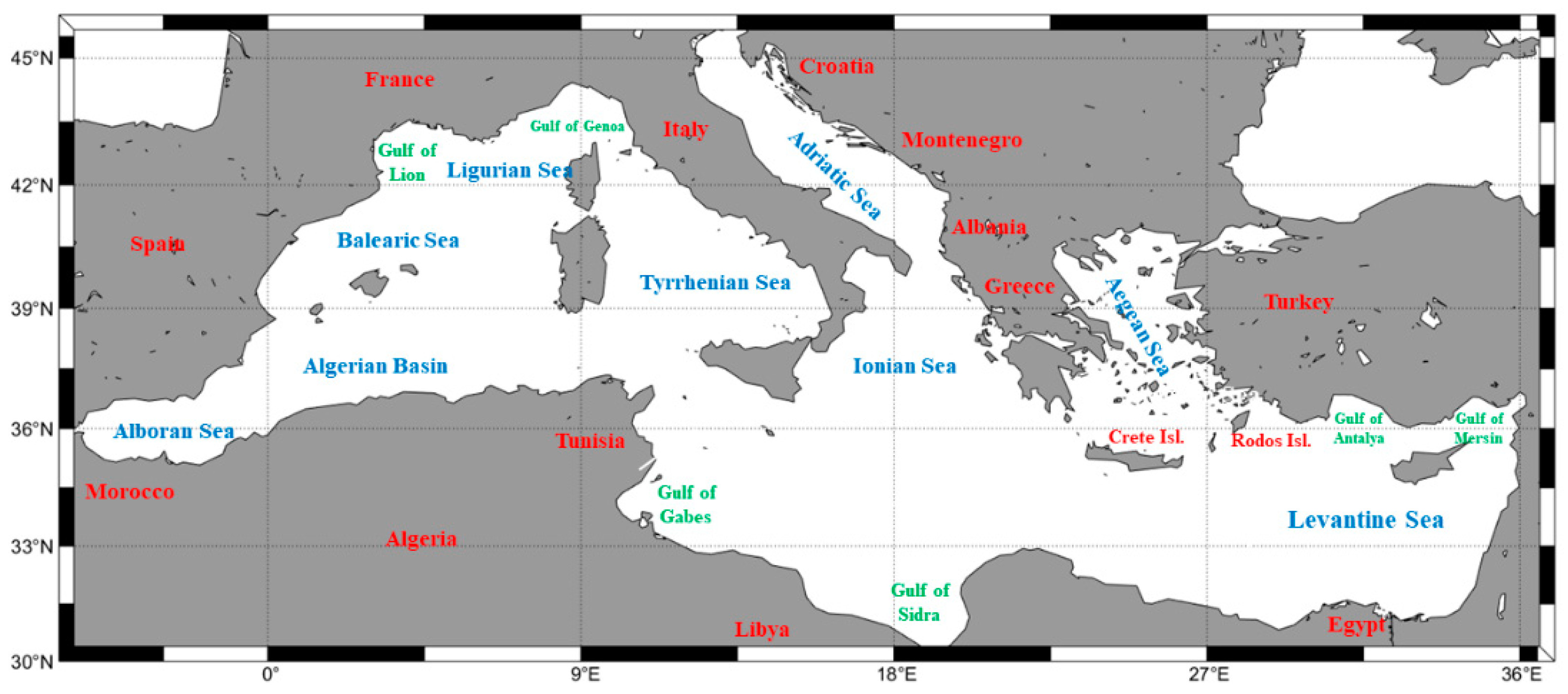
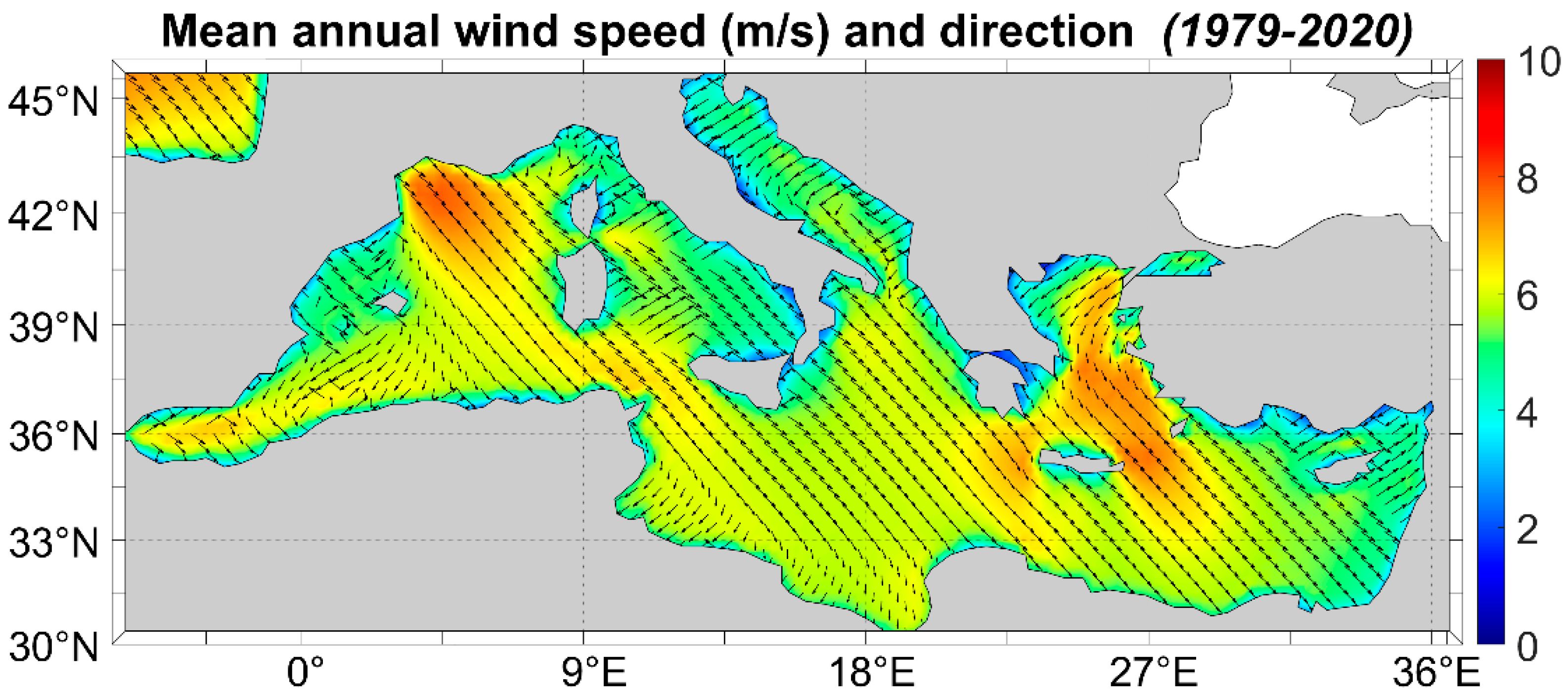
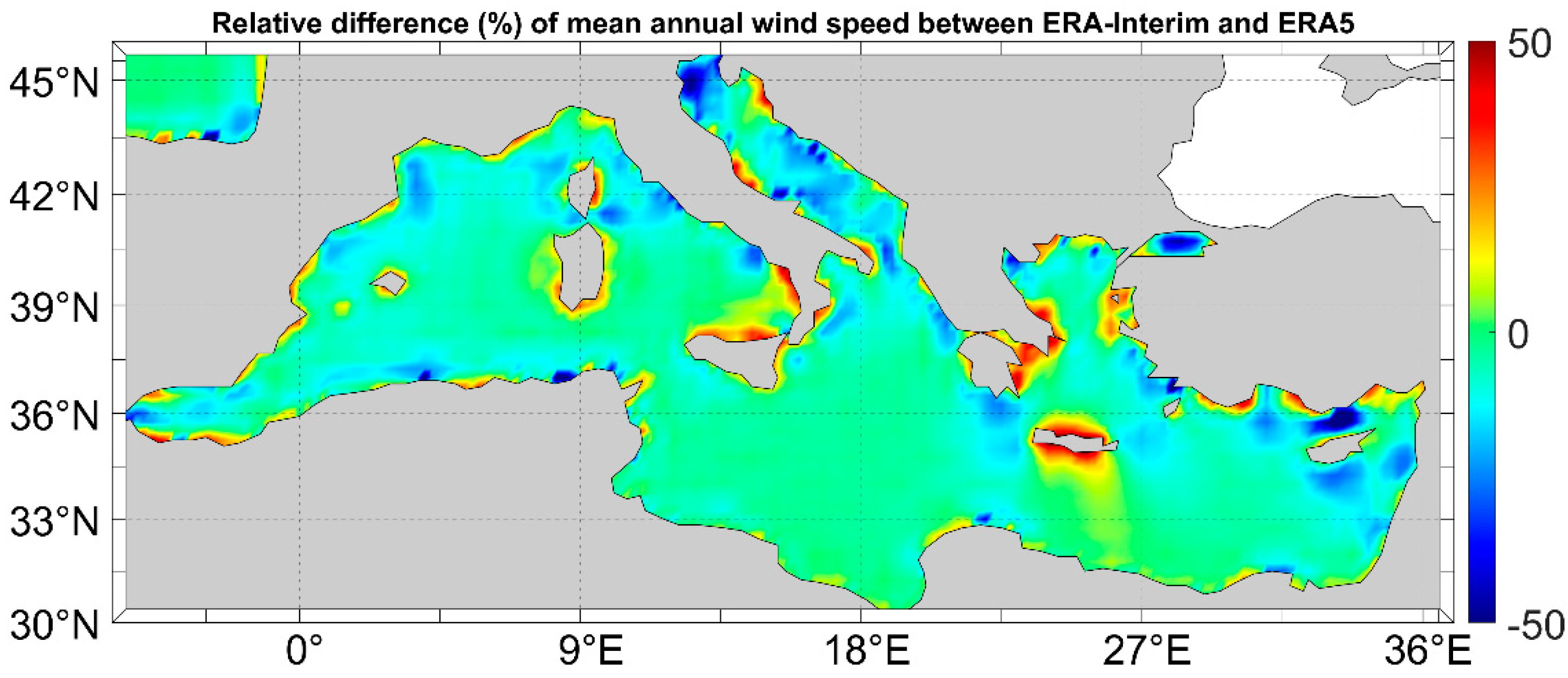

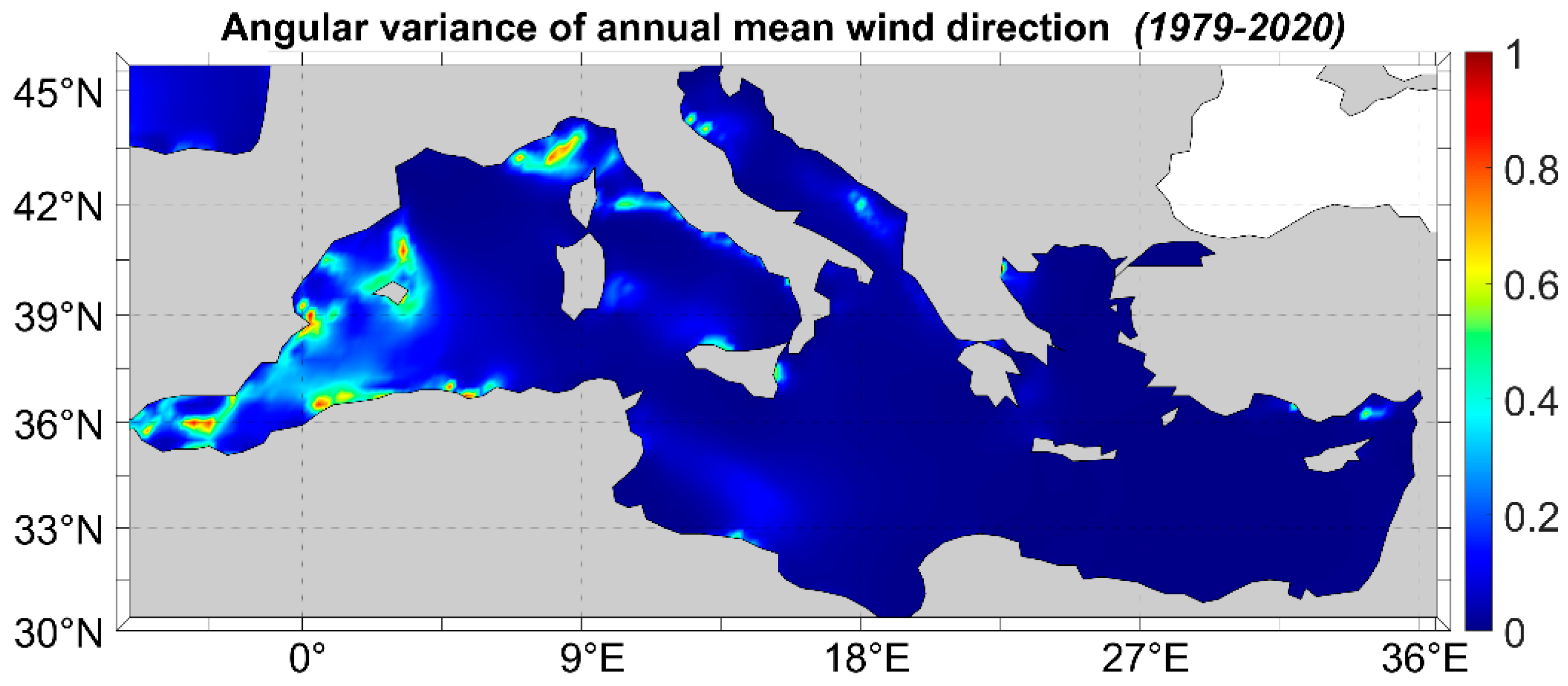


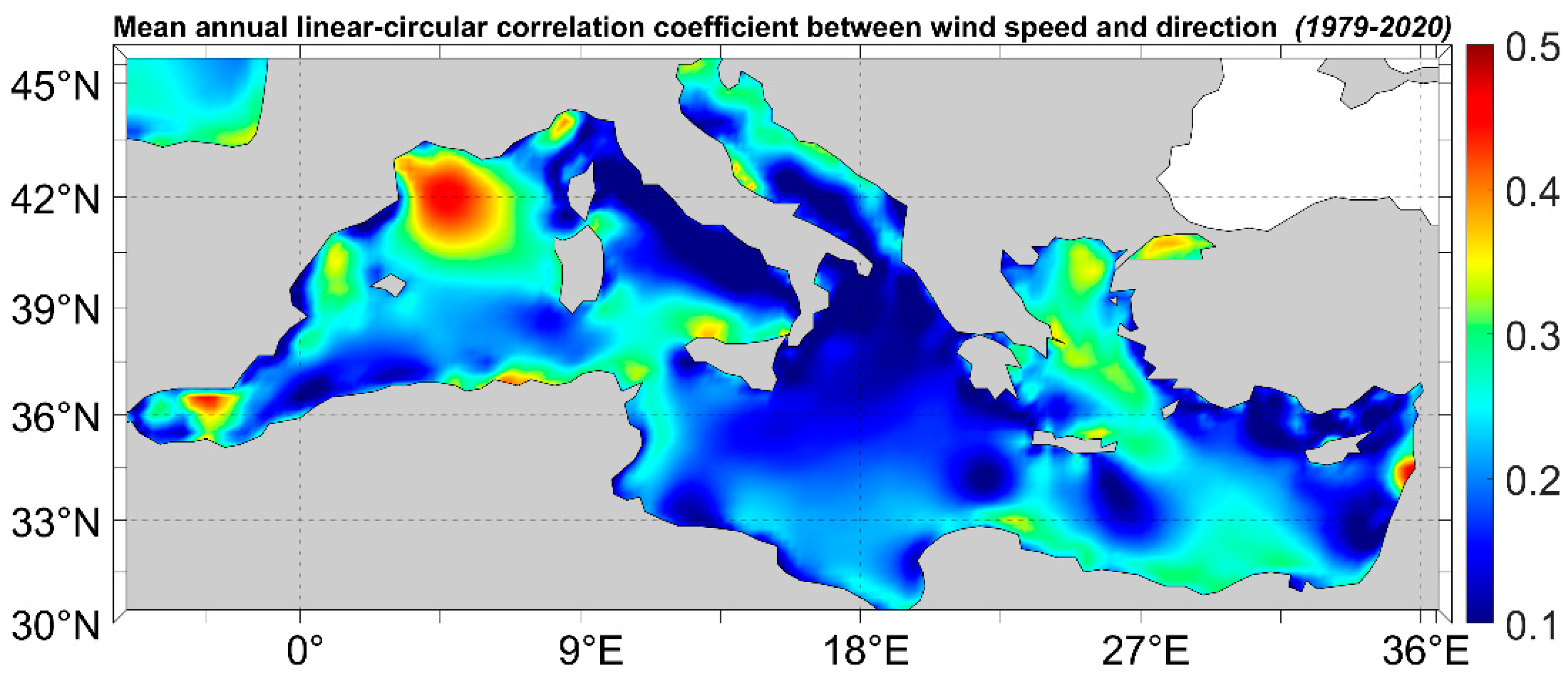
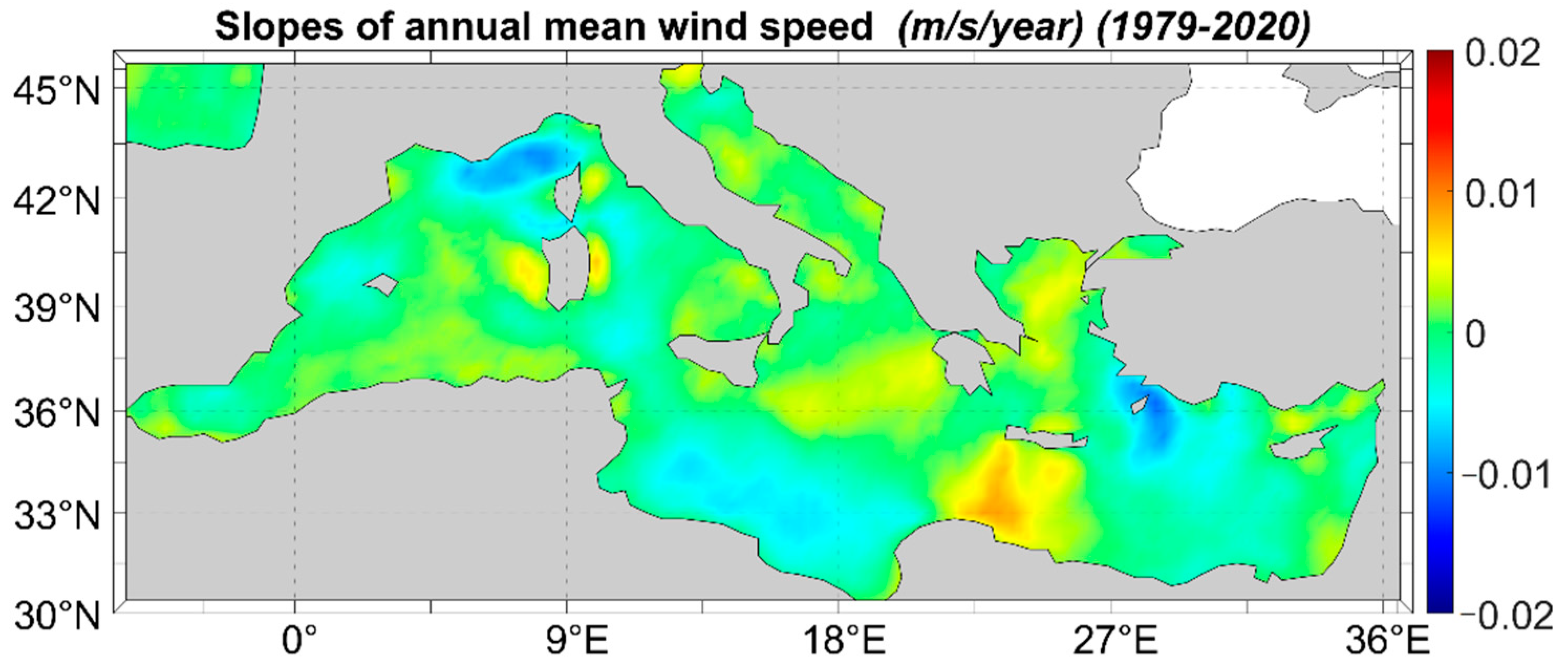
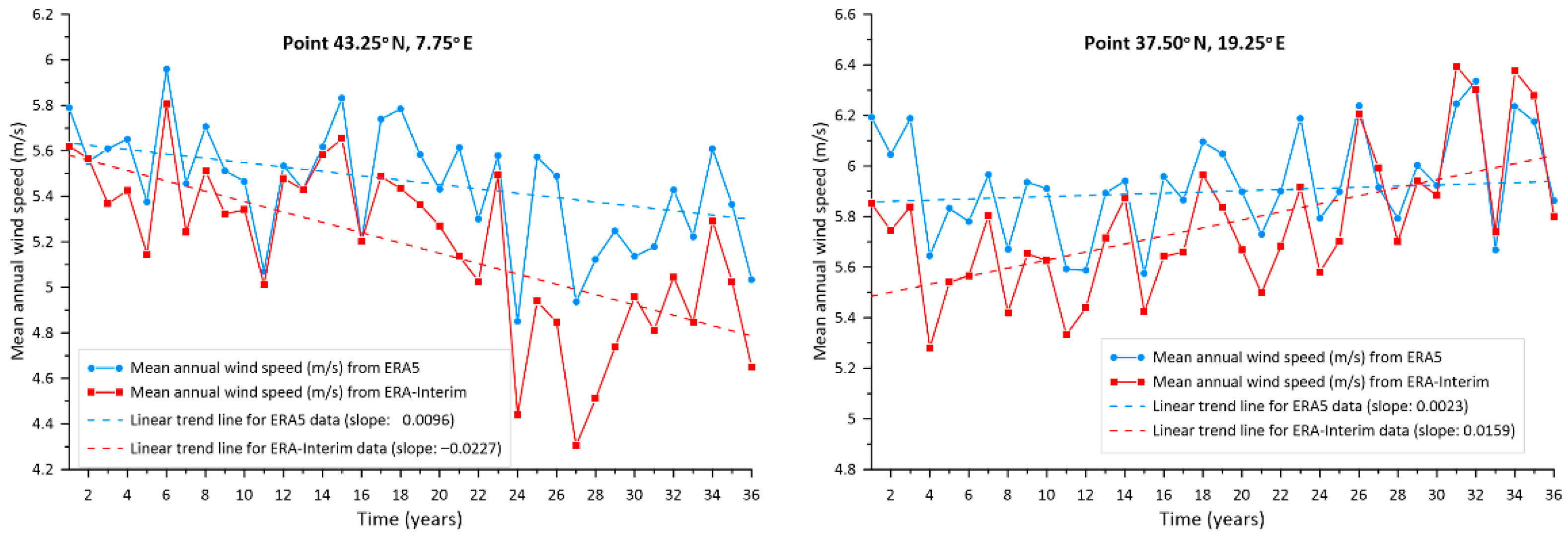
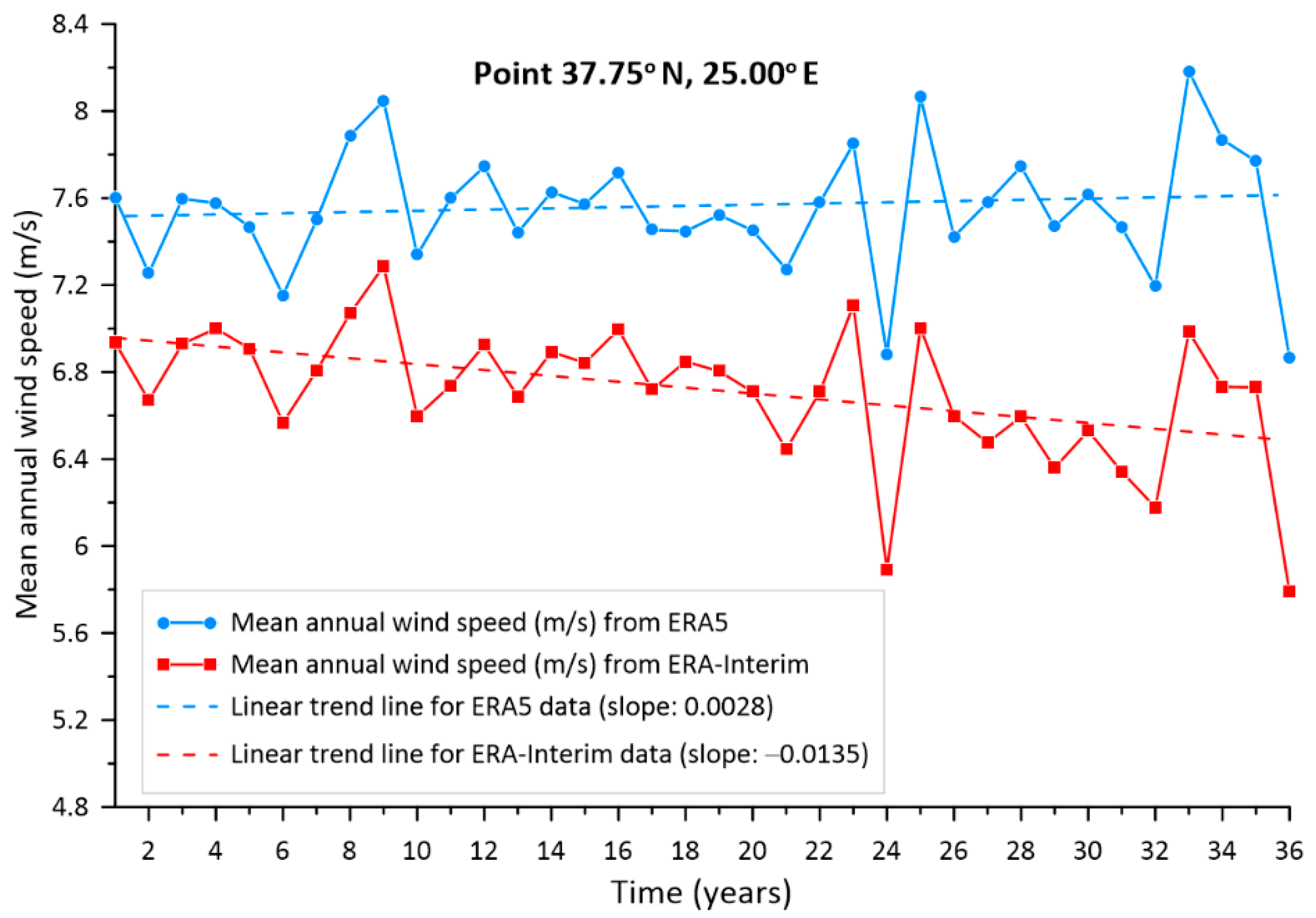





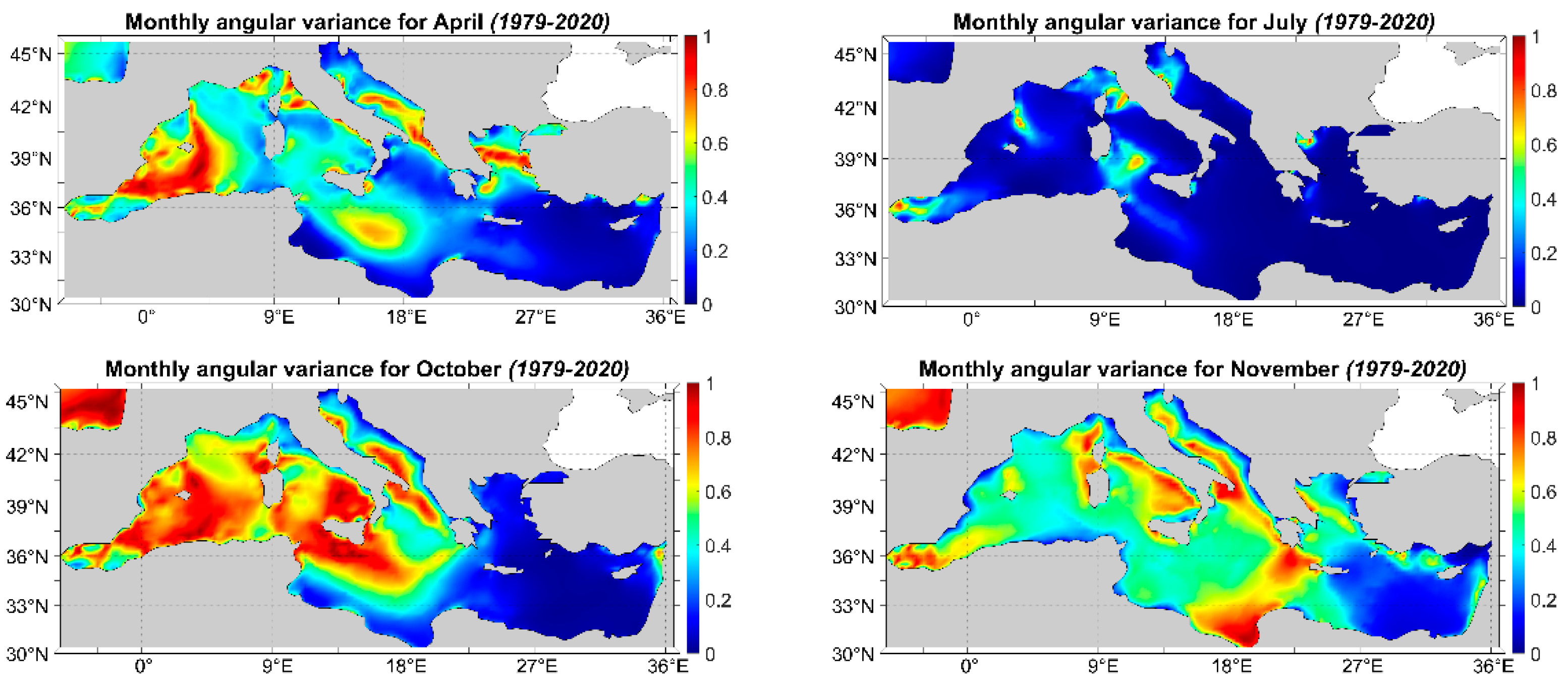
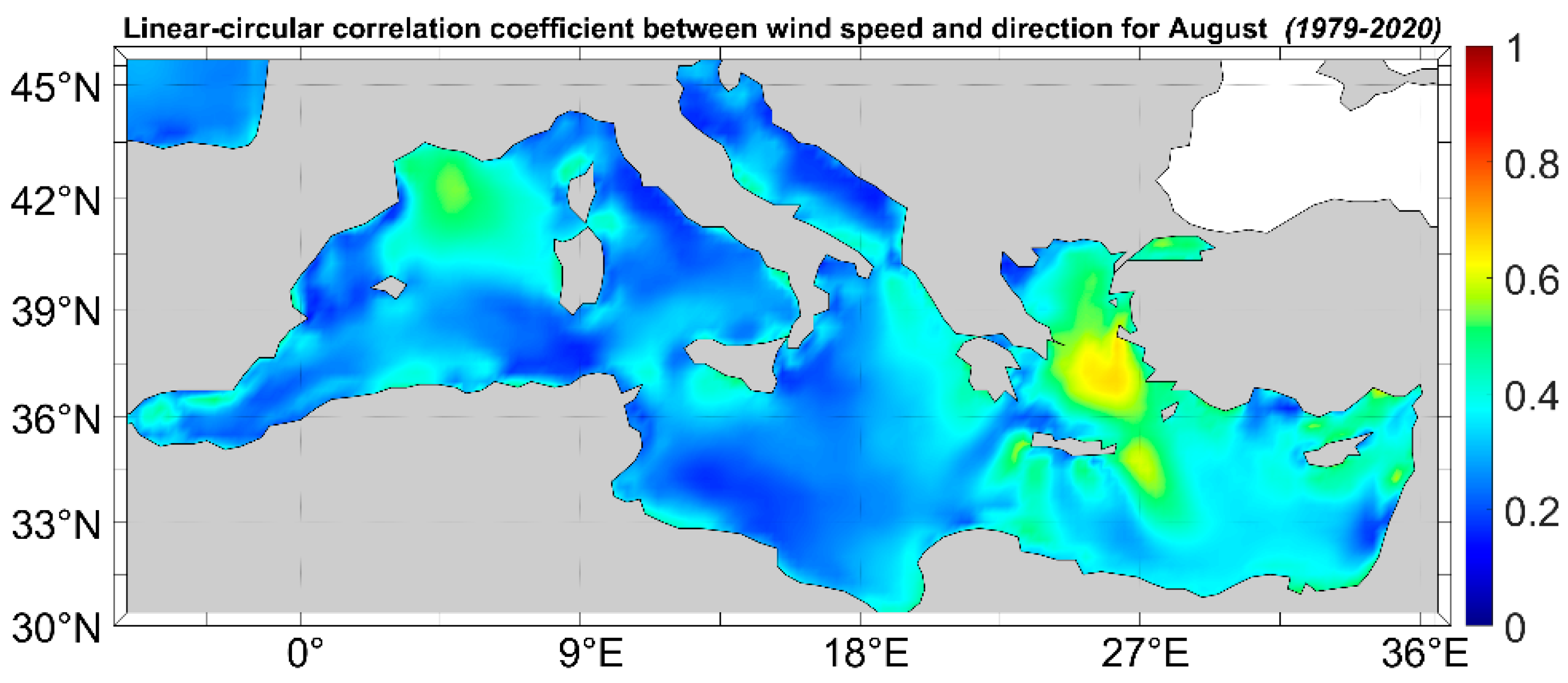
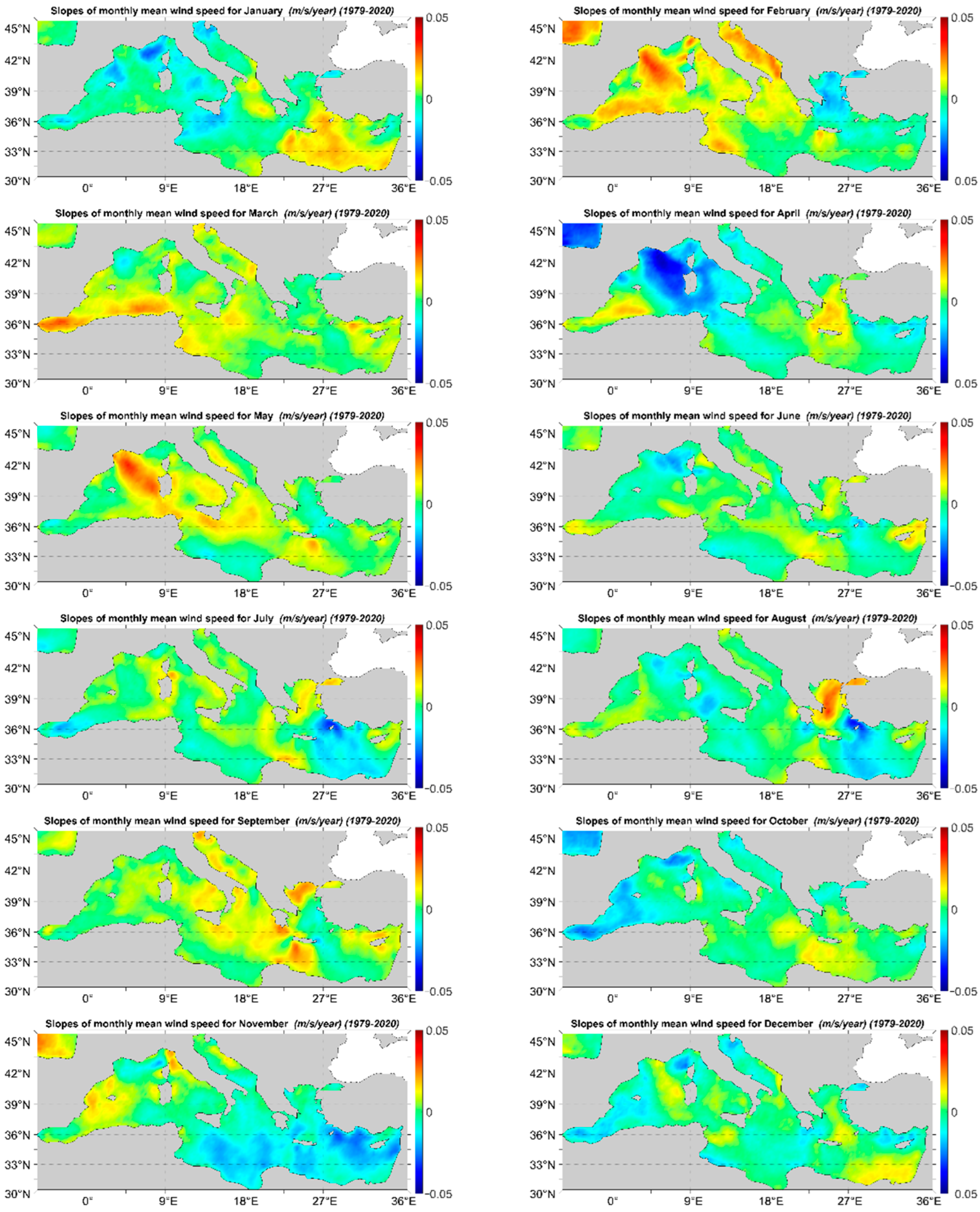

Publisher’s Note: MDPI stays neutral with regard to jurisdictional claims in published maps and institutional affiliations. |
© 2022 by the authors. Licensee MDPI, Basel, Switzerland. This article is an open access article distributed under the terms and conditions of the Creative Commons Attribution (CC BY) license (https://creativecommons.org/licenses/by/4.0/).
Share and Cite
Soukissian, T.; Sotiriou, M.-A. Long-Term Variability of Wind Speed and Direction in the Mediterranean Basin. Wind 2022, 2, 513-534. https://doi.org/10.3390/wind2030028
Soukissian T, Sotiriou M-A. Long-Term Variability of Wind Speed and Direction in the Mediterranean Basin. Wind. 2022; 2(3):513-534. https://doi.org/10.3390/wind2030028
Chicago/Turabian StyleSoukissian, Takvor, and Maria-Aliki Sotiriou. 2022. "Long-Term Variability of Wind Speed and Direction in the Mediterranean Basin" Wind 2, no. 3: 513-534. https://doi.org/10.3390/wind2030028
APA StyleSoukissian, T., & Sotiriou, M.-A. (2022). Long-Term Variability of Wind Speed and Direction in the Mediterranean Basin. Wind, 2(3), 513-534. https://doi.org/10.3390/wind2030028






